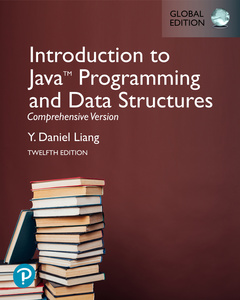Description
Introduction to Java Programming and Data Structures, Comprehensive Version, Global Edition (12th Ed.)
Author: Liang Y.
Language: English
1240 p. · 20.5x25.4 cm · Paperback
Description
/li>Contents
/li>Biography
/li>Comment
/li>
This text is intended for a 1-semester CS1 course sequence. The Brief Version contains the first 18 chapters of the Comprehensive Version. The first 13 chapters are appropriate for preparing the AP Computer Science exam.
For courses in Java Programming.
A fundamentals-first introduction to basic programming concepts and techniques
Designed to support an introductory programming course, Introduction to Java Programming and Data Structures teaches you concepts of problem-solving and object-orientated programming using a fundamentals-first approach. Beginner programmers learn critical problem-solving techniques then move on to grasp the key concepts of object-oriented, GUI programming, data structures, and Web programming. This course approaches Java GUI programming using JavaFX, which has replaced Swing as the new GUI tool for developing cross-platform-rich Internet applications and is simpler to learn and use. The 12th edition has been completely revised to enhance clarity and presentation, and includes new and expanded content, examples, and exercises.
Also available with MyLab Programming.
MyLab ProgrammingTM is an online learning system designed to engage students and improve results. MyLab Programming consists of programming exercises correlated to the concepts and objectives in this book. Through practice exercises and immediate, personalized feedback, MyLab Programming improves the programming competence of beginning students who often struggle with the basic concepts of programming languages.
Note: You are purchasing a standalone product; MyLab Programming does not come packaged with this content. Students, if interested in purchasing this title with MyLab Programming, ask your instructor to confirm the correct package ISBN and Course ID. Instructors, contact your Pearson representative for more information.
- Introduction to Computers, Programs, and JavaTM
- Elementary Programming
- Selections
- Mathematical Functions, Characters, and Strings
- Loops
- Methods
- Single-Dimensional Arrays
- Multidimensional Arrays
- Objects and Classes
- Object-Oriented Thinking
- Inheritance and Polymorphism
- Exception Handling and Text I/O
- Abstract Classes and Interfaces
- JavaFX Basics
- Event-Driven Programming and Animations
- JavaFX UI Controls and Multimedia
- Binary I/O
- Recursion
- Generics
- Lists, Stacks, Queues, and Priority Queues
- Sets and Maps
- Developing Efficient Algorithms
- Sorting
- Implementing Lists, Stacks, Queues, and Priority Queues
- Binary Search Trees
- AVL Trees
- Hashing
- Graphs and Applications
- Weighted Graphs and Applications
- Aggregate Operations for Collection Streams
Bonus Chapters 31–44 are available from the Companion Website
- Advanced JavaFX and FXML
- Multithreading and Parallel Programming
- Networking
- Java Database Programming
- Advanced Database Programming
- Internationalization
- Servlets
- JavaServer Pages
- JavaServer Faces
- RMI
- Web Services
- 2-4 Trees and B-Trees
- Red-Black Trees
- Testing Using JUnit
Appendixes
- A. Java Keywords and Reserved Words
- B. The ASCII Character Set
- C. Operator Precedence Chart
- D. Java Modifiers
- E. Special Floating-Point Values
- F. Number Systems
- G. Bitwise Operations
- H. Regular Expressions
- I. Enumerated Types
- J. The Big-O, Big-Omega, and Big-Theta Notations
Dr. Y. Daniel Liang earned his Ph.D. in Computer Science from the University of Oklahoma in 1991, and an MS and BS in Computer Science from Fudan University in Shanghai, China, in 1986 and 1983. Prior to joining Armstrong, he was an associate professor in computer science at Purdue University in Fort Wayne, where he twice received the Excellence in Research award.
Dr. Liang was trained in theoretical computer science. He was active in graph algorithms from 1990 to 1995 and published more than ten papers in several established journals such as SIAM Journal on Computing, Discrete Applied Mathematics, Acta Informatics, and Information Processing Letters. Since 1996, he has devoted to writing texts and published more than thirty books with Prentice Hall. His popular computer science texts are widely adopted in the world.
Dr. Liang was elected a Java Champion in 2005 by Sun Microsystems and has given lectures on Java internationally.
Hallmark Features
- Check Points provide review questions to help students track their progress as they read through the chapter and evaluate their learning.
- The Chapter Summary reviews the important subjects that students should understand and remember. It helps them reinforce the key concepts they have learned in the chapter.
- Notes, Tips, Cautions and Design Guides are inserted throughout the text to offer valuable advice and insight on important aspects of program development.
- Problems and Case Studies teach problem-solving and programming concepts. The book uses many small, simple and stimulating examples to demonstrate important ideas.
- Quizzes are accessible online and grouped by sections for students to self-test programming concepts and techniques.
These books may interest you

Building Python Programs 142.39 €



